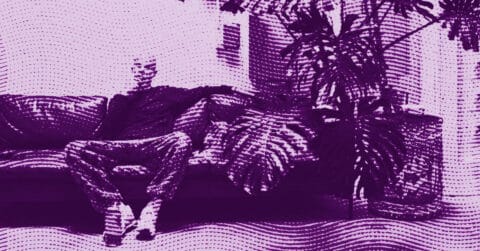Listen to me carefully, you bunch of snobs: while you marvel at the latest conceptual installations in New York, a woman born in Hawaii spent her days with her hands immersed in the clay of New Jersey, patiently building a work that would render your lazy distinctions between art and craft obsolete. Toshiko Takaezu (1922-2011) never sought your approval, and it is precisely for this reason that she deserves all your attention today.
The official history of 20th-century art likes to tell itself as a succession of heroic ruptures, thunderous manifestos, and tortured geniuses. Takaezu, on the other hand, grew vegetables between firings, considered pottery and cooking as inseparable activities, and stubbornly refused to date her works other than by decades. This calculated indifference to the usual temporal markers already constituted an act of silent rebellion against the art market’s obsession with traceability and chronology. As she put it with disarming simplicity: “In my life, I see no difference between making pots, cooking, and growing vegetables. They are all so connected.”[1].
The architecture of interiority
Takaezu’s closed forms must be understood as fully-fledged architectural structures. When she seals the top of her ceramics leaving only a tiny opening, she does not forsake functionality out of aesthetic whim. She literally constructs edifices for the invisible. These enclosed volumes, which she called “closed forms,” establish a relationship to space that belongs more to architecture than to traditional pottery. Each piece becomes a secret chamber, a portable sanctuary, a miniature cathedral dedicated to darkness.
Since Vitruvius, architecture concerns itself with firmitas, utilitas, and venustas: solidity, utility, and beauty. Takaezu radically shifts this triptych. Her works unmistakably possess solidity, acquired through firing at over 1250 degrees Celsius. They manifest undeniable beauty, although some purists of Japanese ceramics may have grimaced at her bold colors. But utility? She completely redefines it. The utility of these forms lies in their ability to shelter emptiness, to protect intact darkness, to preserve a space that no one will ever see.
This conception of interior space as a precious entity finds echoes in the sacred architecture of multiple traditions. The Buddhist stupas, which she certainly observed during her eight-month stay in Japan in 1955, contain inaccessible reliquary chambers. European Romanesque churches hide underground crypts. Takaezu transposes this logic of the hidden sanctuary to the scale of the domestic object. Each “moon pot,” each closed cylinder thus becomes the receptacle of a mystery deliberately withdrawn from view.
The artist herself articulated this concern with astonishing clarity during a studio visit in 1975 in Hilo: “The most important thing in this piece is the dark space you cannot see, the dark air that is inside it and that you cannot see” [2]. This statement deserves close attention. Takaezu is not speaking of a neutral or abstract void. She evokes a “dark space,” a “dark air,” giving a nearly tangible materiality to the absence of light. Darkness becomes substance, an architectural element to be worked on just like the visible clay.
The dimensions of her works also participate in this architectural logic. Her “Star Series” from the late 1990s reach a human scale, sometimes exceeding 1.5 meters in height. At this size, the pieces are no longer contemplated. One moves around them, encounters them, temporarily inhabits their presence. The experience recalls that of wandering around a monument or inside an architectural installation. These ceramic totems create their own territory, change the circulation within the exhibition space, and impose a particular choreography on the viewer.
The construction process itself reveals an architectural thinking. Takaezu did not only use the potter’s wheel. She assembled coils, joined slabs, and modeled by hand. This construction through progressive accumulation resembles masonry techniques. Each addition of material consolidates the building, raises the walls of this jealously guarded interior space. The final firing in her imposing nearly 8 cubic meter two-chamber kiln resembles testing a structure against the elements.
Before sealing her forms definitively, Takaezu frequently inserted a fragment of clay wrapped in paper. During firing, the paper would burn away and the clay would harden, creating a rattle inside each piece. This gesture introduces a sound dimension into ceramic architecture. The works no longer merely occupy space visually. They acoustically inhabit it when handled. The invisible interior space is signaled by this sound of stone rolling in a closed cave. Architecture becomes musical, the static object contains kinetic and auditory potential.
This attention paid to the interior space dialogues with the concerns of 20th-century modernist architects, even if Takaezu would probably never have claimed this affiliation. When Le Corbusier defines architecture as “the learned, correct, and magnificent play of volumes assembled under the light,” Takaezu responds with the equally learned play of volumes subtracted from the light. She creates anti-spaces, portable dark rooms, architectures for absence.
The poetry of visible silence
If Takaezu’s forms constitute architectures, their surfaces resemble visual poems. The artist never wrote a manifesto, rarely commented on her work in theoretical terms. Her language was expressed directly on the ceramic skin of her creations. The gestures of glazing, drips, splashes, and broad brush sweeps compose a poetic vocabulary that refuses literal narration.
Modern poetry, since Mallarmé, explores the white of the page as a signifying element. Typographic silence, spacings, and absences participate as much in the poem as the visible words. Takaezu transposes this logic to ceramics. Her surfaces are never completely covered. She lets the terracotta breathe, leaving areas where the stoneware or porcelain appear in their nudity. These unglazed zones function like the whites of the poem, like the silences of a musical score.
The exhibition “The Poetry of Clay” organized at the Philadelphia Museum of Art in 2004 bore a fitting title. It was not a complacent metaphor. Takaezu’s ceramics truly operate according to a poetic logic. They condense, elide, suggest rather than describe. Just as a line of poetry concentrates more meaning than prose, each brushstroke laden with coppery or cobalt glaze carries an outsized semantic intensity relative to its small surface area.
The titles chosen by the artist reinforce this poetic dimension. “Moon”, “Eclipse”, “Zeus”, “Sophia”, “White Peach”, “Floating Seaweed”: these names evoke rather than designate. They open associative spaces, multiple cultural resonances. “Shiro Momo” (white peach) simultaneously summons the fleshy fruit, the absent color, Japanese folk tales. A single title branches off in several semantic directions, exactly like a successful poetic image.
The glazing technique itself is part of a gestural tradition that crosses Asian calligraphy and Western abstract expressionism. Takaezu did not hide her admiration for American painters of the New York School, notably Jackson Pollock and Franz Kline. But unlike their paintings, her surfaces carry the memory of fire. High-temperature firing unpredictably alters colors, modifies textures, produces controlled accidents. This element of chance introduces a radical otherness into the work. The artist does not fully control the final result. The kiln, the flames, the oxidizing or reducing atmosphere become co-authors.
This dialogue with the unexpected brings Takaezu closer to poets who practice formal constraints or aleatory procedures. Raymond Queneau with his Hundred Thousand Billion Poems, John Cage with his chance-driven scores: all sought to introduce a dimension escaping egotistical control into creation. Takaezu, entrusting her pieces to the kiln, accepted a similar form of creative dispossession. Metallic oxides, according to slight variations in temperature and oxygenation, shifted from green to pink, from black to coppery red. Each firing became an unprecedented reading of the same poem-form.
The “Tree Forms” series from the 1970s particularly illustrates this poetics of mourning and memory. Inspired by the charred trees of the Devastation Trail in Hawaii Volcanoes National Park, these tall slender columns evoke ghost trunks. Takaezu does not mimetically reproduce these dead trees. She distills their poetic essence: broken verticality, post-eruptive blackness, petrified fragility. These works function as ceramic elegies, tomb poems erected in memory of a vanished forest.
The artist refused to consider clay as an inert material. She declared: “Clay is a sensitive, living, animated, and reactive being” [3]. This attributions of sensitivity to the raw material reflects an animistic conception found in certain poetic traditions. Japanese haiku, for example, presupposes a continuity between human consciousness and natural phenomena. Takaezu, nourished by Okinawan culture and Zen Buddhism, shared this intuition of a diffuse life in the material world.
Her extended stays in Hawaii, her native land to which she regularly returned, imbued her works with a particular sensitivity to the elements. The deep blue of certain pieces evokes the Pacific Ocean. The flows of brown and ochre glazes recall the basaltic lava streams. The rounded shapes of the “moon pots” echo the pebbles smoothed by the waves. This geological poetry anchors the work in a concrete sensory experience of the island landscape.
Silence occupied a central place in her practice and pedagogy. Her former students remember a workshop almost devoid of written instructions, where learning occurred through observation and gestural imitation rather than verbal explanation. This rejection of theoretical logorrhea reflects a conviction: some truths cannot be formulated in words. They are shown, passed from hand to hand, inscribed in muscle memory. Poetry, ultimately, also aspires to say what ordinary prose cannot capture.
The paradoxical legacy
So here we have an artist who built invisible architectures and composed silent poems. Toshiko Takaezu deserves better than the convenient labels generally attached to creators from so-called applied disciplines. She was neither a potter-who-also-makes-art nor an artist-who-works-with-ceramics. These bureaucratic distinctions would have made her smile or shrug.
Her true legacy lies in this quiet determination to work on her own terms, without concern for institutional taxonomies. The contemporary art market took decades to recognize her contribution. Major retrospectives multiplied only after her death in 2011. This late recognition highlights the persistent blindness of a system still largely determined by obsolete hierarchies between noble and minor mediums.
Today, in 2025, as museums compete to exhibit contemporary ceramists and prices of clay works skyrocket at auctions, it would be tempting to celebrate Takaezu’s posthumous triumph. Let us be wary of this self-satisfaction. The late incorporation of an artist into the canon does not erase decades of institutional indifference. On the contrary, it reveals the pathetic slowness with which official art structures revise their prejudices.
Takaezu’s closed forms contain a lesson that far exceeds the realm of ceramics. They remind us that any work worthy of the name necessarily harbors an irreducible part to analysis, a core of darkness preserved from our voracious interpretations. What we do not see, what we do not fully understand, participates as much in the aesthetic experience as the immediately identifiable elements. The black space inside each pot is not a flaw in transparency. It constitutes the very condition of poetic resonance.
Takaezu also teaches us the necessity of long time, of slow maturation far from the limelight of the media. She built her work patiently, firing after firing, vegetable harvest after vegetable harvest, over nearly six decades. That duration defies contemporary impatience, the thirst for immediate recognition, the race for likes and posts. Her example suggests that an authentic creative life is measured in years accumulated in the studio, not in magazine covers.
The rattles enclosed in her ceramics emit a discreet, almost intimate sound when handling the pieces. This secret tinkling perhaps represents the essential: true art does not scream, does not impose itself through loud violence. It whispers, suggests, invites listening closely. In the deafening uproar of today’s art world, saturated with explanations, press releases, proliferating content, Toshiko Takaezu’s ceramic murmur resonates as a salutary call for restraint, focus, and listening to what refuses to reveal itself immediately.
- Montclair Art Museum, Toshiko Takaezu: Four Decades, exh. cat., Montclair, New Jersey, Montclair Art Museum, 1989
- Dandee Pattee, “Toshiko Takaezu: Expressions in Clay,” Ceramics: Art and Perception, no. 88, 2012
- Jennifer Saville, “Toshiko Takaezu: Listening to Clay,” Toshiko Takaezu, exh. cat., Honolulu, Honolulu Academy of Arts, 1993
















